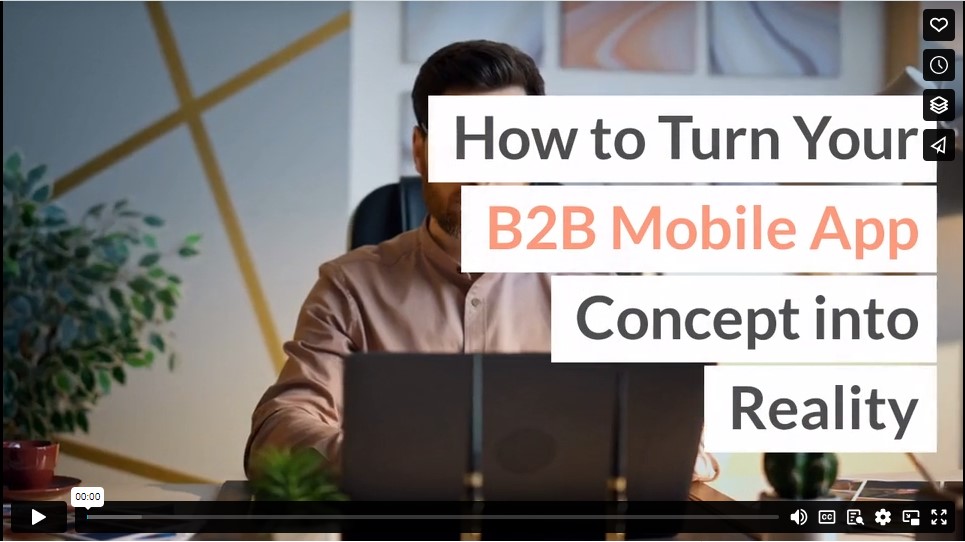There’s nothing quite like the feeling you get when you have a great app idea. What many entrepreneurs and business owners can tell you is that the ideation part is easy — it’s the building, launching, and stimulating adoption that causes all the headaches.
But there’s a recipe that can help make the process more manageable and fruitful. This is especially true for B2B apps, where you generally won’t have the same validation challenges that B2C apps have. After all, you’ve already got an established customer base and a solid understanding of your industry and how you fit in.
Let’s go over what it takes to get that mobile web app out of your head and into the hands of your customers.
1. Listen to your customers
You don’t necessarily need to dive into market research right off the bat. The best possible source of intel you have is right in front of you: your existing customers. Because they’re already paying you for your products or services, you don’t need to wonder if your new idea is going to work or who’s going to use it.
Dig into your existing user and performance data to paint a clear picture of your customers: who they are, their needs and motivators, and what they feel are the thorns in their side. And when you’re done extrapolating all this from your own data, talk to them about it directly.
You can try crowdsourcing ideas or running your existing ideas by them and getting their feedback. You can do this through things like surveys, focus groups, and one-on-one interviews. When you hear it straight from your customers, you’ll have explicit, actionable data to sculpt the foundations of your new app.
2. Work out the financials
Before you start building, it’s important to know how the new app is going to affect your current revenue model. Will it add to or take away from any of your existing revenue streams, or is it an entirely new one? Make sure you understand the financial implications and potential return on investment. You might benefit from running through some good old-fashioned statements like a cash flow, cost, and income projection.
You’ll be in a much better position once you have a solid understanding of things like:
- How the app will integrate and coexist with your other services and offerings
- The investments you need to make to create a solid, sustainable app versus a quick-and-dirty MVP (which you should definitely try to avoid in this context)
- How the app will generate a return on investment (ROI) for your company
- Any other ways the app might impact your company’s bottom line in the long run
3. Phase out the build
There are three general phases of the building process: design, technical planning, and the actual build. Let’s take a look at each.
Design
This phase focuses on the problem you’re trying to solve and what you want to achieve with your new B2B mobile app. This is where you dig into questions like the purpose of your app, what value it will provide to your users, and what specific features and functions it will have.
The result is a roadmap that guides the next phases of development, laying out the collaborative and technical aspects of the build-out while still leaving room for any changes that come up as you go.
Technical planning
Here’s the fun part (for your developers). This is where all the technical considerations are made in terms of the tools and processes that will turn your concept into a functioning app. In this phase, the app development team will look at things like the tech stack, system architecture, API design, coding approach, and technical feasibility.
At the end of this phase, there shouldn’t be any questions about what’s getting done and how. That’s all squared away and your developers are ready to get to work.
Actual build
When many people think of the app development process, they think of it being built out completely and you’re done. But the way we do it is through an agile development process. This means that development happens in cycles instead of all at once.
When the build is broken into cycles, there are opportunities to test as you go. You can see what works and what doesn’t, and pivot if you need to.
4. Release and refine
Once the development process is done, it’s time to let the world see your masterpiece. Going back to the previous point, this is another process where people assume it’s one-and-done. But like development, the release should also be viewed with an iterative mindset.
See how the app is performing on its initial release. Get in touch with the users you interviewed earlier to get their feedback on how the app turned out. Ask them what they like, what they don’t like, and what they think could benefit from some changes.
You’ll find that this feedback is worth its weight in gold. Take it seriously, and implement changes as they come. By staying responsive to user feedback, you’ll help to keep your user base loyal and boost the app’s long-term success.
5. Harness your early adopters
When it comes to marketing your app and getting more people to use it, pay special attention to your early adopter audience. These are the users who are willing to take risks and try out the hottest new tools and features. They’ll be able to give you exceptional feedback to continue the ‘release and refine’ strategy in the last step, in addition to helping you generate word-of-mouth in your industry and really breathe life into your app.
Turning great ideas into great apps
While the process of building a B2B mobile app might seem daunting or impossibly complex, it’s not so bad when you have a proven process (and a team of experts who know how to get the job done right).
When you lead with value and your end users in mind, you can be sure that you’re fulfilling the need you set out to fulfill. And when you give the process room to breathe and evolve, you’ll be able to harness feedback and insights that may not have occurred to you before.
The end result: a darn good B2B mobile app.
Video





